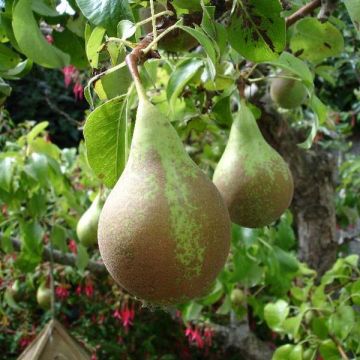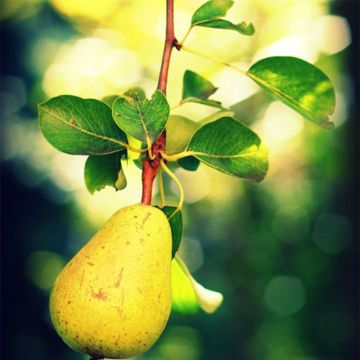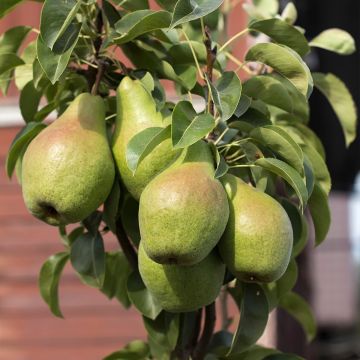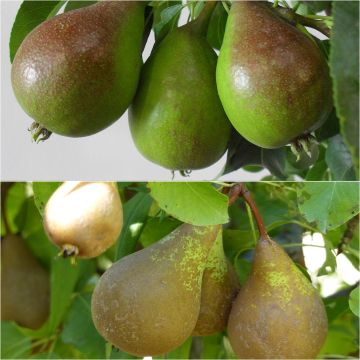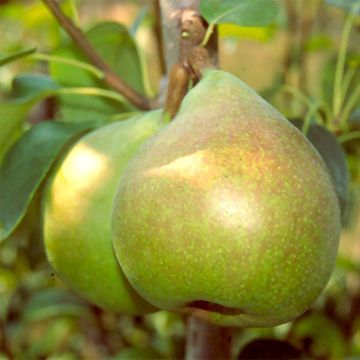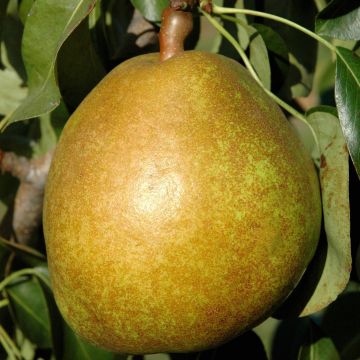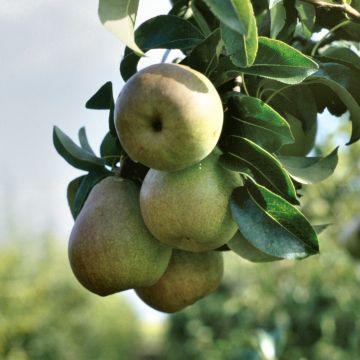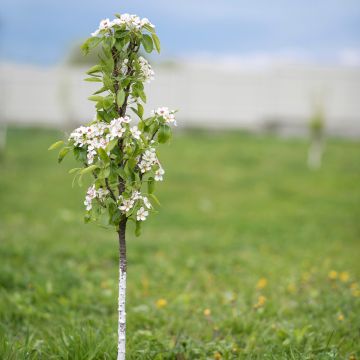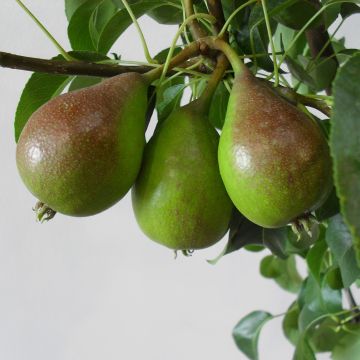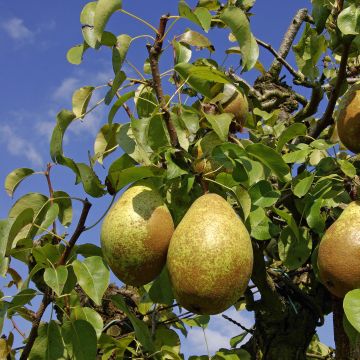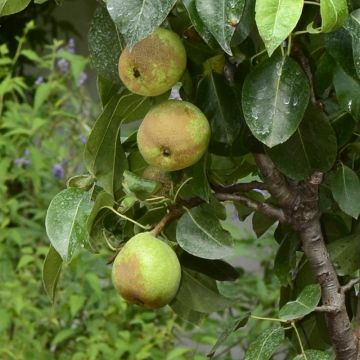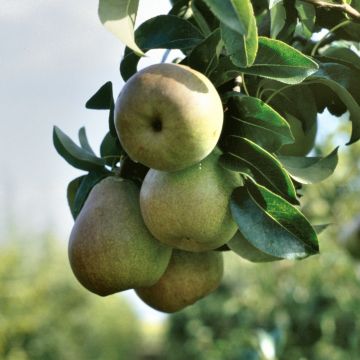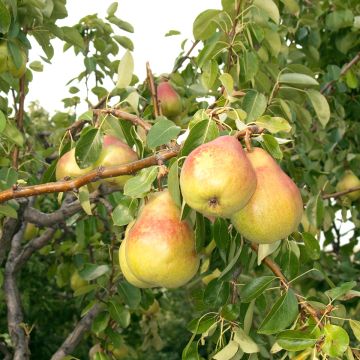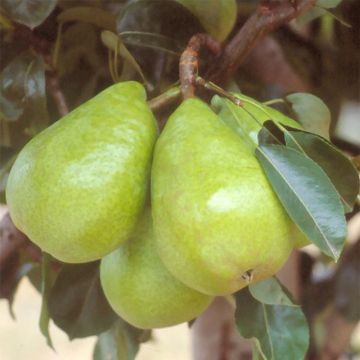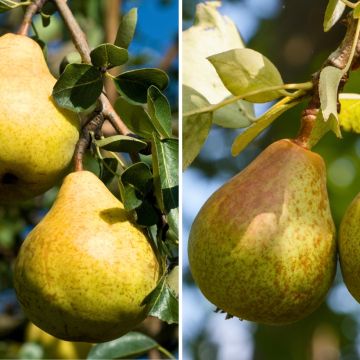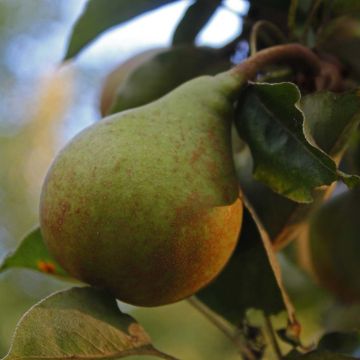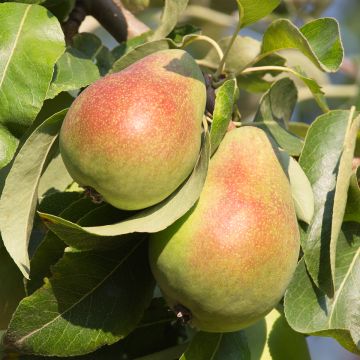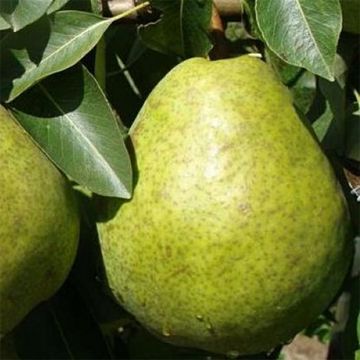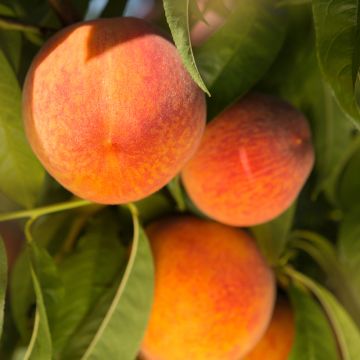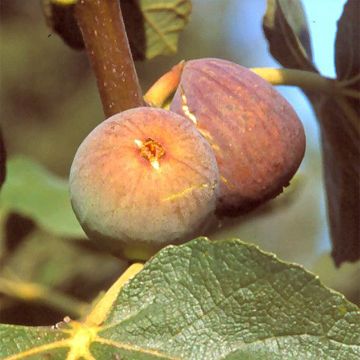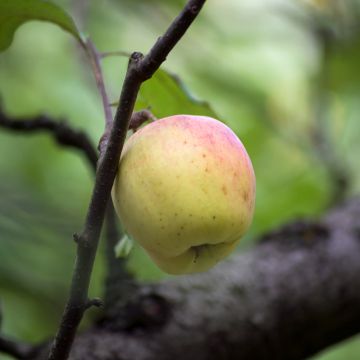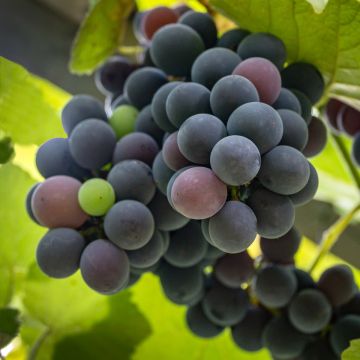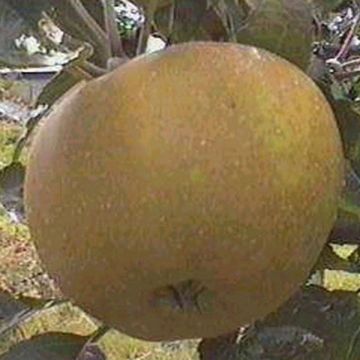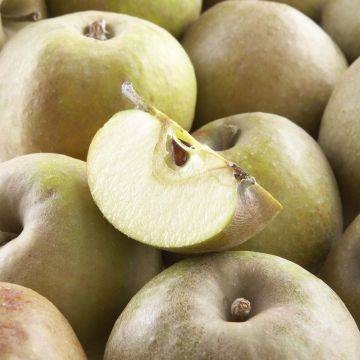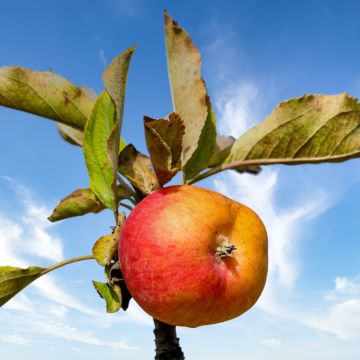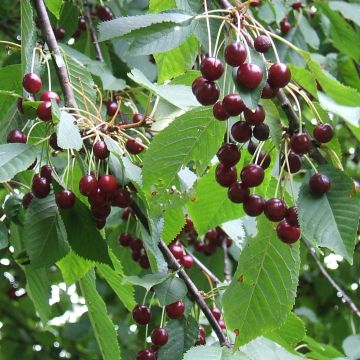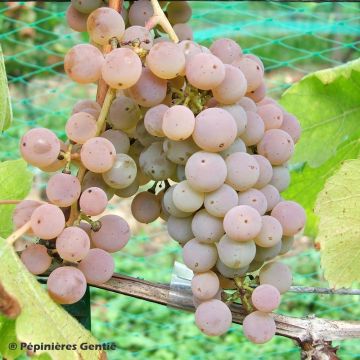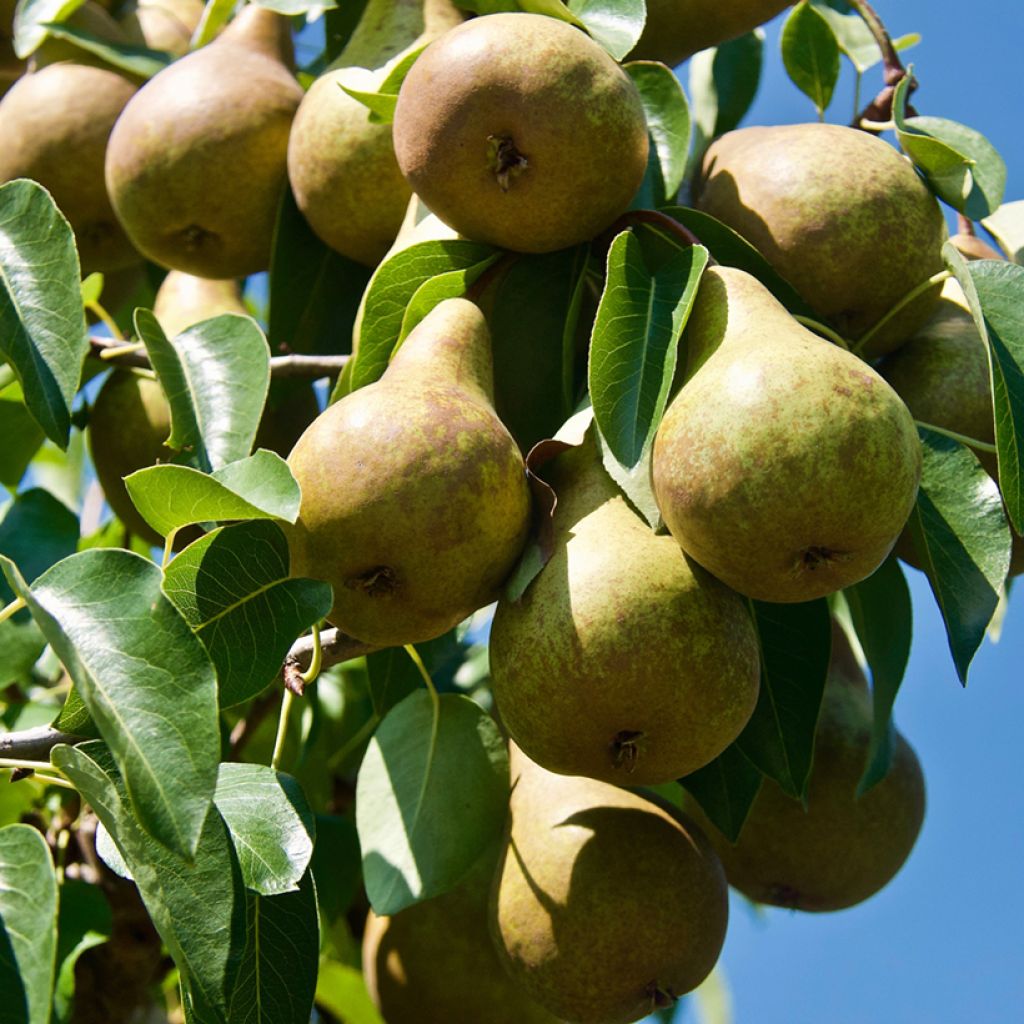

Poirier Précoce de Trévoux
Pyrus communis Précoce de Trévoux - Pear Tree
Pyrus communis Précoce de Trévoux
Common Pear, European Pear
Why not try an alternative variety in stock?
View all →This plant carries a 6 months recovery warranty
More information
We guarantee the quality of our plants for a full growing cycle, and will replace at our expense any plant that fails to recover under normal climatic and planting conditions.
Oversize package: home delivery by special carrier from €6.90 per order..
Express home delivery from €8.90.
Delivery to Corse prohibited: UE law prohibits the import of this plant from mainland France to Corse as part of the fight against Xylella fastidiosa. Please accept our sincere apologies.
More information

Description
The Early Trevoux Pear is an old, fertile and vigorous variety that ensures good and regular yields. It produces a medium-sized fruit, pyriform and plump in shape, widely truncated towards the pedicel. Its thin skin is light green, turning yellow when ripe, with shades of carmine pink when exposed to sunlight. Its white flesh is firm, fine, melting, juicy, very sweet, pleasantly acidic, and almost seedless. The harvest extends from mid-August to early September, and the fruits are consumed as soon as they are picked and only keep for a few days, as they ripen quickly and become mealy. Subtly acidic and rich in sugar, it is a dessert pear, delicious to enjoy raw. Cooked, it is a variety that lends itself well to many sweet or savoury recipes, to the production of excellent pear syrup, or to the making of preserved pears in syrup. It is a partially self-fertile variety that requires the presence of other pear varieties nearby to improve pollination and increase the number of fruits. Very resistant to diseases, it is resistant to scab.
Pyrus communis (Common Pear) is a fruit tree belonging to the Rosaceae family. Present in Europe since ancient times, it originated in the forests of Western Asia. In France, pear trees appeared in the 16th century, when several species were cultivated in the gardens of the king under the reign of Louis XIV. Over the centuries, a very large number of cultivars have emerged. Its cultivation is widespread in Europe.
The Early Trevoux variety was obtained around 1862 by Mr. François Treyve (1818-1911), a horticulturist from Trevoux, in the Ain department, in the Rhône-Alpes region. This pear tree forms a fairly erect tree with a canopy that can reach approximately 5 meters (16 feet) in height and 4 meters (13 feet) in width when fully grown, producing numerous spreading branches. Its habit is well suited to low forms (goblet shape) or espaliers (fan or cordon), avoiding tall standards as the fruits easily drop. Its deciduous foliage is composed of large leaves measuring 8 to 10 cm (3 to 4in) in length, alternate, ovate, and shiny green, turning yellow-orange in autumn. The flowering occurs in April, which generally protects it from frost. The white flowers, single, 2 to 3 cm (1in) in diameter, grouped in umbels, are nectariferous. They can be destroyed by frost from -2 to -3°C (28.4 to 26.6°F). It is a hardy tree that tolerates temperatures around -25°C (-13°F) and is suitable for cultivation in all regions of France, including at high altitudes. This Pear tree is self-sterile or self-incompatible, meaning the flowers cannot self-pollinate. That is why the presence of other pear varieties in the vicinity, with flowering occurring at the same time, is necessary. For example, the varieties Beurré Hardy, Conference, Doyenné du Comice, Jules Guyot, Louise Bonne d'Avranches, William's Bon Chrétien, and William's Rouge are suitable for cross-pollination, thus increasing the number of fruits.
The Early Trevoux pear tree is a high-yielding variety, very fertile, with rapid fruiting and abundant and regular fruit production. The harvest begins from mid-August, and the fruits are consumed as soon as they are picked at their ripeness. The pear can be eaten raw or cooked, in compotes, pastries, and desserts, in fruit salads or mixed salads, in combination with cheeses, or as an accompaniment to savory dishes, alongside ducks, white meats (poultry and lamb), or game. It is also perfect for making juices or preserved fruits in syrup. Rich in water, the pear refreshes and quenches thirst. Very fleshy, it provides a great feeling of satiety. Moderately caloric, it is well supplied with potassium, calcium, and magnesium, with a significant iron content. Its content of vitamins C and E, antioxidants, and fibers make the pear a health asset. It is invigorating, energizing, and rehydrating. It is best to harvest the fruits a few days before they are fully ripe, as they do not become overripe quickly, but they can only be stored for a few days.
Very popular thanks to its fruits, the pear tree finds its place in the garden for the pleasure of young and old. Among a wide range of pear trees, it is easy to find the variety that best suits one's desires.
Report an error about the product description
Plant habit
Fruit
Flowering
Foliage
Botanical data
Pyrus
communis
Précoce de Trévoux
Rosaceae
Common Pear, European Pear
Cultivar or hybrid
Other Pear trees
Planting and care
Your Organic Early Trévoux Pear Tree, needing warmth, will be planted sheltered from prevailing winds, and preferably in full sun. Pear trees thrive in damp, rich soils without stagnant moisture, but do not tolerate excessively dry or chalky soils. Pear trees, like all fruit trees, are ideally planted between October and March, avoiding periods of frost. Container-grown trees can be planted throughout the year, except during periods of extreme heat or frost.
To plant, loosen the soil deeply, remove stones and unwanted weeds. Add some gravel to improve drainage if necessary. Dig a large planting hole at least 3 times the volume of the root ball. Make sure to separate the subsoil from the topsoil. Mix bonemeal and organic matter (potting soil, compost, etc.) with the subsoil and pour this mixture into the bottom of the planting hole. Place the root ball, cover with the topsoil without burying the graft union, and firm down. Water generously (about 10 liters). It may be beneficial to stake the pear tree by installing a guy-wire system: plant 3 stakes in a triangle 50 cm (20in) around the trunk, connect them with pieces of wood. Protect the bark with a piece of rubber, for example, and attach the stakes to the trunk with wire. It is also possible to espalier it on a support (U-palmette or Verrier palmette, for example).
For maintenance, every year in autumn, apply well-rotted compost on the surface. Then, in winter, add a small scoop of wood ash, rich in potash, to improve fruiting. Hoe if necessary around the base of the tree. Regularly water, depending on your climate, during the first two or three years.
Pear trees can be susceptible to various diseases and pests. To prevent scab (brown spots on leaves), brown rot (wilting of flowers and fruit rot on the tree), and powdery mildew (white powdery coating on leaves), spray with Bordeaux mixture and horsetail decoctions. As for pests, the codling moth or fruit worm, a small caterpillar, can be controlled by installing bird and bat boxes, placing corrugated cardboard strips along the trunk, and bagging the fruits in brown kraft paper. In case of aphid infestation, spray a mixture of water and black soap.
Planting period
Intended location
Care
This item has not been reviewed yet - be the first to leave a review about it.
Ancient and local varieties
Haven't found what you were looking for?
Hardiness is the lowest winter temperature a plant can endure without suffering serious damage or even dying. However, hardiness is affected by location (a sheltered area, such as a patio), protection (winter cover) and soil type (hardiness is improved by well-drained soil).

Photo Sharing Terms & Conditions
In order to encourage gardeners to interact and share their experiences, Promesse de fleurs offers various media enabling content to be uploaded onto its Site - in particular via the ‘Photo sharing’ module.
The User agrees to refrain from:
- Posting any content that is illegal, prejudicial, insulting, racist, inciteful to hatred, revisionist, contrary to public decency, that infringes on privacy or on the privacy rights of third parties, in particular the publicity rights of persons and goods, intellectual property rights, or the right to privacy.
- Submitting content on behalf of a third party;
- Impersonate the identity of a third party and/or publish any personal information about a third party;
In general, the User undertakes to refrain from any unethical behaviour.
All Content (in particular text, comments, files, images, photos, videos, creative works, etc.), which may be subject to property or intellectual property rights, image or other private rights, shall remain the property of the User, subject to the limited rights granted by the terms of the licence granted by Promesse de fleurs as stated below. Users are at liberty to publish or not to publish such Content on the Site, notably via the ‘Photo Sharing’ facility, and accept that this Content shall be made public and freely accessible, notably on the Internet.
Users further acknowledge, undertake to have ,and guarantee that they hold all necessary rights and permissions to publish such material on the Site, in particular with regard to the legislation in force pertaining to any privacy, property, intellectual property, image, or contractual rights, or rights of any other nature. By publishing such Content on the Site, Users acknowledge accepting full liability as publishers of the Content within the meaning of the law, and grant Promesse de fleurs, free of charge, an inclusive, worldwide licence for the said Content for the entire duration of its publication, including all reproduction, representation, up/downloading, displaying, performing, transmission, and storage rights.
Users also grant permission for their name to be linked to the Content and accept that this link may not always be made available.
By engaging in posting material, Users consent to their Content becoming automatically accessible on the Internet, in particular on other sites and/or blogs and/or web pages of the Promesse de fleurs site, including in particular social pages and the Promesse de fleurs catalogue.
Users may secure the removal of entrusted content free of charge by issuing a simple request via our contact form.
The flowering period indicated on our website applies to countries and regions located in USDA zone 8 (France, the United Kingdom, Ireland, the Netherlands, etc.)
It will vary according to where you live:
- In zones 9 to 10 (Italy, Spain, Greece, etc.), flowering will occur about 2 to 4 weeks earlier.
- In zones 6 to 7 (Germany, Poland, Slovenia, and lower mountainous regions), flowering will be delayed by 2 to 3 weeks.
- In zone 5 (Central Europe, Scandinavia), blooming will be delayed by 3 to 5 weeks.
In temperate climates, pruning of spring-flowering shrubs (forsythia, spireas, etc.) should be done just after flowering.
Pruning of summer-flowering shrubs (Indian Lilac, Perovskia, etc.) can be done in winter or spring.
In cold regions as well as with frost-sensitive plants, avoid pruning too early when severe frosts may still occur.
The planting period indicated on our website applies to countries and regions located in USDA zone 8 (France, United Kingdom, Ireland, Netherlands).
It will vary according to where you live:
- In Mediterranean zones (Marseille, Madrid, Milan, etc.), autumn and winter are the best planting periods.
- In continental zones (Strasbourg, Munich, Vienna, etc.), delay planting by 2 to 3 weeks in spring and bring it forward by 2 to 4 weeks in autumn.
- In mountainous regions (the Alps, Pyrenees, Carpathians, etc.), it is best to plant in late spring (May-June) or late summer (August-September).
The harvesting period indicated on our website applies to countries and regions in USDA zone 8 (France, England, Ireland, the Netherlands).
In colder areas (Scandinavia, Poland, Austria...) fruit and vegetable harvests are likely to be delayed by 3-4 weeks.
In warmer areas (Italy, Spain, Greece, etc.), harvesting will probably take place earlier, depending on weather conditions.
The sowing periods indicated on our website apply to countries and regions within USDA Zone 8 (France, UK, Ireland, Netherlands).
In colder areas (Scandinavia, Poland, Austria...), delay any outdoor sowing by 3-4 weeks, or sow under glass.
In warmer climes (Italy, Spain, Greece, etc.), bring outdoor sowing forward by a few weeks.

































